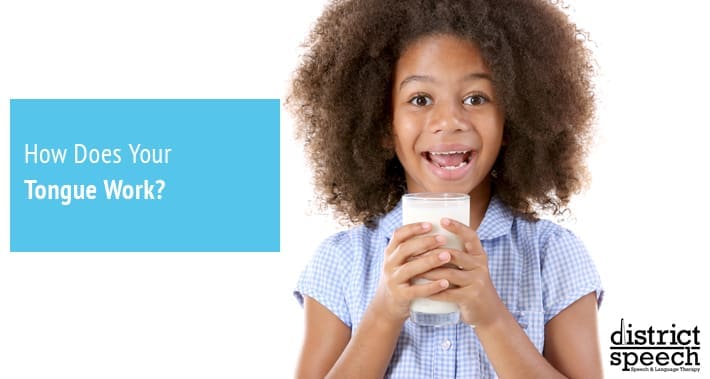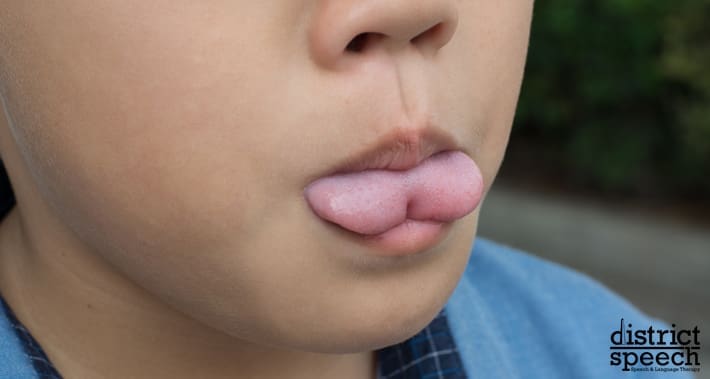
Your tongue is responsible for so many things.
It helps you eat, taste, and salivate.
Your tongue is also responsible for your speech, creating the shapes that you need to make different sounds when you talk.
Because it is such a complex organ, your tongue is related to a number of different speech disorders.
Speech disorders like tongue thrust happen when your tongue doesn’t do exactly what it should when you’re speaking.
Speech therapy for tongue thrust is one way to resolve this.
That’s true of other tongue related speech disorders as well.
But before we get too much into that, let’s talk about how your tongue works.
What Is Your Tongue?
You might not think of it this way, but your tongue is a muscle.
More specifically, it’s a combination of eight different muscles.
But while most muscles in your body develop around a bone that supports them (think of your bicep, for example), your tongue’s muscles intertwine with each other.
This creates what anatomists call a muscular hydrostat, and it might be weird to think of it this way, but your tongue has a lot in common with an octopus tentacle.
Like a tentacle, it has an extreme range of motion compared with the other muscles in your body.
Tongues have many nerves and are supplied with a lot of blood.
While the root of your tongue is firmly in place at the floor of your mouth, the majority of it can move freely.
With your mouth closed, your tongue will take up almost the entire space of your mouth because it is such a large set of muscles.
Muscles and ligaments in the upper part of the throat keep your tongue attached to the hyoid or lingual bone, near your larynx.
Muscles also connect your tongue to your lower jaw and even to the base of your skull.
Different Sections Of Your Tongue
Your tongue has a number of different sections that have different responsibilities.
The tip and sides of your tongue are capable of complex movements.
The tip’s ability to move like this is one of the reasons we humans are able to make many of the speech sounds we use.
What includes the upper surface of your tongue is called the back of your tongue.
This is where the sensory cells that give you your sense of taste are located.
Connected to the floor of your mouth is the root of your tongue.
This is also called the base of your tongue and cannot be seen from outside of your mouth.
What Does Your Tongue Do?
The tongue is responsible for many vital activities, including:
- Eating and drinking
- Sucking
- Chewing and grinding
- Salivating
- Swallowing
- Tasting
- Touching
- Speaking
• Defending your body against pathogens
Probably the most important job of the tongue is helping you eat.
The tongue helps turn your food into something you can swallow, differentiate flavors, and enables swallowing itself.
Your tongue also has its own defense cells, called the lingual tonsil.
This helps your body defend against germs that come in through the mouth.
How Does Your Tongue Affect Speech?
The movability of your tongue is one of the main things that helps you speak.
It can make more than 20 different movements.
Your tongue works with your lips and teeth to make differentiable sounds, as the sounds that come from your throat would not be as articulate on their own.
Moreover, your tongue can produce more than 90 words per minute.
Without your tongue, you would not be able to pronounce consonants like t, d, l, or k.
Speech Disorders Associated With Your Tongue
Pronouncing the letter s involves moving the tip of your tongue backwards.
If you keep your tongue between your teeth, your s will sound like a lisp.
Lisps are one of the speech disorders associated with your tongue.
While most speech disorders involve the tongue in some way, these some that are more prominent disorders.

1. Tongue Thrust
If your child has tongue thrust, some of the signs may include their being an exceptionally messy eater, breathing mostly through their mouth, or having trouble making the s and z sounds.
This is caused by your child’s tongue pressing further forward in their mouth than normal – hence the name.
It usually originates in infancy, before your child grew their first teeth.
At this point, they had to push their tongue forward so they could create a seal with their lips in order to swallow properly.
Many children grow out of this, but in some cases it sticks around, and can cause issues with feeding, speech, and dental development.
2. Tongue Tie
Tongue tie, also known as ankyloglossia, is a condition that is present from birth that restricts the range of motion of your tongue.
Tongue tie is characterized by the lingual frenulum, a tight band of tissue, being unusually short.
This can cause your child to have issues sticking out their tongue or affect how they eat, speak, or swallow.
Speech therapy treatments for tongue tie can help.
3. Childhood Apraxia Of Speech
Childhood apraxia of speech means the brain has difficulty sending the right signals to your mouth for muscle movement.
This is not caused by muscle weakness, but a poor connection between the brain and the muscles that form speech.
Some signs and symptoms of childhood apraxia of speech include delayed onset of first words, only being able to make a limited amount of sounds, and mixing up sounds.
Speech therapy treatments for apraxia of speech tend to have good results if started early.
4. Lisp
As stated above, a lisp is when you have trouble pronouncing “s” or “z” sounds.
Sometimes it’s caused by the sides of your tongue not being high or tense enough in your mouth.
There are four different kinds of lisps, depending on the placement of your tongue:
- Interdental lisp: tongue sticks between teeth, airflow directed forward
- Dentalized lisp: tongue rests on your front teeth, producing a muffled sound
- Lateral lisp: air escapes over the sides of the tongue
- Palatal lisp: the midsection of the tongue meets far back of the soft palate
Regardless of the type, speech therapy for children with lisp can considerably reduce your child’s lisp.
Book Your Appointment With District Speech Today
Our Washington DC speech therapists can help with the various speech disorders, helping to get your tongue to cooperate while you’re speaking.
If you or your child has a speech or language, disorder, we can help.
Book your appointment with District Speech today.
1300 I St NW, Suite 400 E,
Washington, DC 20005
- https://g.page/districtspeech
District Speech and Language Therapy specializes in speech therapy, physical therapy, and occupational therapy solutions, for both children and adults, in the Washington D.C and the Arlington Virginia areas.